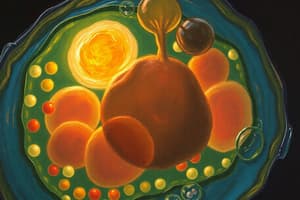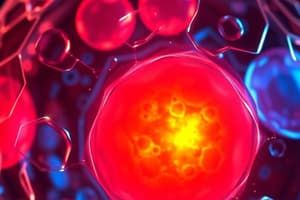Podcast
Questions and Answers
What is the primary role of vacuoles in plant cells?
What is the primary role of vacuoles in plant cells?
Which organelle is responsible for providing structural support and shape to the cell?
Which organelle is responsible for providing structural support and shape to the cell?
Which of the following is NOT a component of the cytoskeleton?
Which of the following is NOT a component of the cytoskeleton?
Which organelle is involved in the breakdown of fatty acids and detoxification of harmful substances?
Which organelle is involved in the breakdown of fatty acids and detoxification of harmful substances?
Signup and view all the answers
What is the difference between cytoplasm and cytosol?
What is the difference between cytoplasm and cytosol?
Signup and view all the answers
Which organelle is responsible for modifying, packaging, and sorting proteins and lipids?
Which organelle is responsible for modifying, packaging, and sorting proteins and lipids?
Signup and view all the answers
Which of these is NOT a function of the Endoplasmic Reticulum (ER)?
Which of these is NOT a function of the Endoplasmic Reticulum (ER)?
Signup and view all the answers
What distinguishes rough ER from smooth ER?
What distinguishes rough ER from smooth ER?
Signup and view all the answers
Why are mitochondria often called the "powerhouses" of the cell?
Why are mitochondria often called the "powerhouses" of the cell?
Signup and view all the answers
Which of these statements accurately describes the relationship between ribosomes and the endoplasmic reticulum?
Which of these statements accurately describes the relationship between ribosomes and the endoplasmic reticulum?
Signup and view all the answers
What is the function of the nuclear envelope?
What is the function of the nuclear envelope?
Signup and view all the answers
What is the primary function of lysosomes?
What is the primary function of lysosomes?
Signup and view all the answers
The statement "Mitochondria contain their own DNA and reproduce independently" suggests that they might have originated from:
The statement "Mitochondria contain their own DNA and reproduce independently" suggests that they might have originated from:
Signup and view all the answers
Study Notes
Introduction to Cell Organelles
- Cell organelles are specialized subunits within a cell that have specific functions.
- They are enclosed within membranes, allowing for distinct environments and controlled activities.
- Organelles work together to carry out various processes, ensuring the cell's survival and function.
- Different types of cells have different sets of organelles, reflecting their unique needs and responsibilities.
Nucleus
- The nucleus is a prominent organelle, often the largest within the cell.
- It serves as the control center, storing the cell's genetic material (DNA).
- It's enclosed by a double membrane called the nuclear envelope, which has pores allowing regulated passage of molecules.
- The DNA within the nucleus is organized into chromosomes, which carry the instructions for building and operating the cell.
Ribosomes
- Ribosomes are small, granular organelles involved in protein synthesis.
- They can either be free-floating in the cytoplasm or attached to the endoplasmic reticulum.
- Ribosomes translate the genetic code from messenger RNA (mRNA) into proteins.
- The two subunits of a ribosome come together during protein synthesis.
Endoplasmic Reticulum (ER)
- The ER is a network of interconnected membranes.
- The rough ER has ribosomes attached, involved in protein synthesis and modification.
- The smooth ER lacks ribosomes and is involved in lipid synthesis, detoxification, and calcium storage.
- The ER is often a major route for protein and lipid transport throughout the cell.
Golgi Apparatus
- The Golgi apparatus is a stack of flattened membrane sacs.
- It modifies, packages, and sorts proteins and lipids received from the ER.
- Proteins and lipids are often tagged and directed to specific destinations within or outside the cell.
- The Golgi apparatus plays a key role in secretion and intracellular transport of molecules.
Mitochondria
- Mitochondria are often called the "powerhouses" of the cell.
- They are responsible for cellular respiration, the process of producing ATP (adenosine triphosphate), the cell's main energy currency.
- Mitochondria have a double membrane, the inner membrane being highly folded to increase surface area for reactions.
- Mitochondria contain their own DNA and reproduce independently of the cell, suggesting an evolutionary past as free-living organisms.
Lysosomes
- Lysosomes are membrane-bound sacs containing digestive enzymes.
- They break down waste materials, cellular debris, and foreign substances.
- Lysosomes are involved in autophagy, the process of breaking down and recycling cellular components.
Vacuoles
- Vacuoles are membrane-bound sacs, typically larger than lysosomes.
- In plant cells, they are very large and maintain turgor pressure, providing structural support.
- They can store water, nutrients, pigments, and other substances.
- Vacuoles in animal cells are smaller and less specialized compared to plant cells.
Chloroplasts (Plant Cells)
- Chloroplasts are only found in plant cells.
- They are the site of photosynthesis, capturing light energy and converting it into chemical energy in the form of sugars.
- Chloroplasts contain pigments, notably chlorophyll, which absorb light energy and are responsible for the green color of plants.
- Like mitochondria, they have their own DNA and reproduce independently.
Cytoskeleton
- The cytoskeleton is a network of protein filaments that provide structural support and shape to the cell.
- It's composed of microtubules, microfilaments, and intermediate filaments.
- The cytoskeleton plays a critical role in cell movement, intracellular transport, and cell division.
Peroxisomes
- Peroxisomes are small, membrane-bound organelles.
- They play a role in a variety of metabolic processes, including the breakdown of fatty acids and the detoxification of harmful substances.
- They contain enzymes that catalyze reactions involving hydrogen peroxide.
Cytoplasm and Cytosol
- The cytoplasm is the jelly-like substance filling the cell.
- It includes all the organelles, excluding the nucleus.
- The cytosol is the liquid component of the cytoplasm, excluding the organelles.
- The cytoplasm provides a medium for cellular activities, facilitating interactions between organelles.
Studying That Suits You
Use AI to generate personalized quizzes and flashcards to suit your learning preferences.
Description
This quiz covers the main types of cell organelles, their functions, and their importance in cellular processes. Learn about the nucleus, ribosomes, and how these structures work together to maintain cell health. Test your knowledge on organelle characteristics and their roles in different types of cells.




